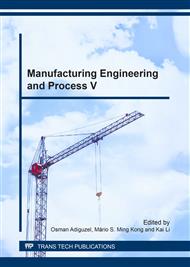p.49
p.55
p.65
p.74
p.83
p.89
p.96
p.100
p.104
Effect of Texturing on the Friction Characteristic of Carbide and Steel Material by Grinding Process
Abstract:
In this paper, friction behavior of textured carbide and steel surface has been studied in order to investigate the effect of different patterns. Several simple textures have been fabricated using straight groove grinding wheel. By microstructuring, various spacing and height of the structure, we investigate the role of topography in terms of friction characteristic. The change of friction behavior has been tailored by grinding operation using straight grooved wheel and evaluated in terms of friction. Friction values were measured by Tribometer. Frictional properties of textured carbide and steel surfaces were assessed with the help of parallel steel slider with 2000g normal force under dry condition using four different sliding speeds. It is found from the experiment that except 30° and 90° angle patterns, rest of the patterns on carbide surfaces show friction reduction which is roughly from 0.15 to 0.13. On the other hand, similar textured patterns can reduce the COF from 0.17 to 0.13 in case of steel surface.
Info:
Periodical:
Pages:
83-88
Citation:
Online since:
March 2017
Authors:
Price:
Сopyright:
© 2017 Trans Tech Publications Ltd. All Rights Reserved
Share:
Citation:


